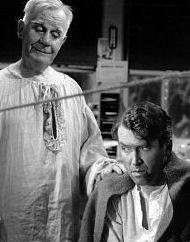Henry Travers
| Henry Travers | |
|---|---|
 Travers in The Bells of St. Mary's (1945) | |
| Born |
Travers John Heagerty 5 March 1874 Prudhoe, Northumberland, England, United Kingdom |
| Died |
18 October 1965 (aged 91) Hollywood, California, U.S. |
| Occupation | Actor |
| Years active | 1894–1949 |
| Spouse(s) |
Amy Forrest-Rhodes (?-1954) (her death) Anna (Ann) Glud Murphy[1] (second marriage) |
Henry Travers (5 March 1874 – 18 October 1965) was an English film and stage character actor. His most famous role was the guardian angel Clarence Odbody in the 1946 film classic It's a Wonderful Life. He also received an Academy Award nomination for his supporting role in Mrs. Miniver (1942). Travers specialized in portraying slightly bumbling but friendly and lovable old men.
Life and career
Early life
Travers was born Travers John Heagerty in Prudhoe, Northumberland, and was the son of Daniel Heagerty, a doctor originally from Ireland. Travers grew up in Berwick-upon-Tweed, and many biographies wrongly report him as being born there.[2] [3]
The Travers family lived in Prudhoe for a couple of years before moving from Woodburn, on the A68 road near Corsenside, Northumberland, in about 1866, to Tweedmouth, Berwick-upon-Tweed, in about 1876.
Initially, he trained as an architect at Berwick, before taking to the stage under the name Henry Travers.
Acting career
Travers played character roles almost from the beginning of his acting career in 1894, often figures who were much older than himself.[4] He made his Broadway debut in 1901, but returned to England. Travers again went to the United States in 1917 after a long and successful theatre career in his homeland. He played frequently from November 1917 until December 1938 on Broadway in over 30 plays. However, his last play on Broadway You Can't Take It with You was his most famous, where he acted in over 380 performances in two years. In the oscar-winning movie You Can't Take It With You, Lionel Barrymore played the role which Travers represented on Broadway.
Like many other theatre actors, he made his first movie only with the advent of sound films. His first was Reunion in Vienna in 1933. In the same year, he played the father of Gloria Stuart in the horror classic The Invisible Man. He often portrayed doctors, judges, and fathers of the main figures in supporting roles. Travers specialized on portraying slightly wry and bumbling but friendly and loveable old men. He appeared with Greer Garson and Ronald Colman in Random Harvest (1942) and with Bing Crosby and Ingrid Bergman in The Bells of St. Mary's (1945). Alfred Hitchcock used Travers as a Comic relief in Shadow of a Doubt (1943), where he played a bank clerk with a passion for criminal magazines. The character actor also portrayed the Railway Station Master Mr. Ballard with a love for roses who finally wins the annual flower show in his village shortly before dying in a bombardment in Mrs. Miniver. He received an Academy Award-nomination as Best Supporting Actor for this appearance.
However, his most famous role was as James Stewart's, somewhat befuddled but kind-hearted guardian angel Clarence Odbody in Frank Capra's It's a Wonderful Life (1946), who saves Stewart's character from a suicide and shows him how wonderful his life really is. Though the film was a financial flop, it later became a Christmas classic and one of the most beloved films in American cinema. Travers retired in 1949 after his supporting role in The Girl From Jones Beach. Overall, he acted in 52 films.
Personal life and death
His first wife was actress Amy Forrest-Rhodes (1881-1954). They were married until Amy's death in 1954. Travers married for a second time to Ann G. Murphy (1899-1983) who was a nurse.
After several years in retirement, Travers died as a result of arteriosclerosis in 1965, at the age of 91. He is buried with his second wife in the Forest Lawn Memorial Park, Glendale.
Filmography

- Reunion in Vienna (1933) - Father Krug
- Another Language (1933) - Pop Hallan
- My Weakness (1933) - Ellery Gregory
- The Invisible Man (1933) - Dr. Cranley
- Death Takes a Holiday (1934)
- Ready for Love (1934)
- Born to Be Bad (1934)
- The Party's Over (1934)
- Maybe It's Love (1935)
- After Office Hours (1935)
- Captain Hurricane (1935)
- Escapade (1935)
- Four Hours to Kill! (1935)
- Pursuit (1935)
- Seven Keys to Baldpate (1935)
- Too Many Parents (1936)
- The Sisters (1938)
- You Can't Get Away with Murder (1939)
- Dodge City (1939)
- Dark Victory (1939)
- On Borrowed Time (1939)
- Stanley and Livingstone (1939)
- The Rains Came (1939)
- Remember? (1939)
- Primrose Path (1940)
- Anne of Windy Poplars (1940)
- Edison, the Man (1940)
- Wyoming (1940)
- High Sierra (1941)
- A Girl, a Guy and a Gob (1941)
- I'll Wait for You (1941)
- The Bad Man (1941)
- Ball of Fire (1941)
- Mrs. Miniver (1942)
- Pierre of the Plains (1942)
- Random Harvest (1942)
- Shadow of a Doubt (1943)
- The Moon Is Down (1943)
- Madame Curie (1943)
- Dragon Seed (1944)
- The Very Thought of You (1944)
- None Shall Escape (1944)
- Thrill of a Romance (1945)
- The Naughty Nineties (1945)
- The Bells of St. Mary's (1945)
- The Yearling (1946)
- It's a Wonderful Life (1946)
- Gallant Journey (1946)
- The Flame (1947)
- Beyond Glory (1948)
- The Girl From Jones Beach (1949) - Judge Bullfinch
References
- ↑ Carp
- ↑ GRO Register of Births, Marriages and Death and 1881 Census for England & Wales
- ↑ http://www.chroniclelive.co.uk/news/north-east-news/you-know-one-most-famous-10655045
- ↑ http://www.nytimes.com/movies/person/71634/Henry-Travers
External links
| Wikimedia Commons has media related to Henry Travers. |
- Henry Travers at the Internet Movie Database
- Henry Travers on television
- Henry Travers at the Internet Broadway Database

- Henry Travers at Find a Grave